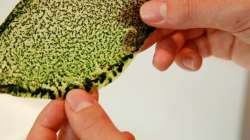Breakthrough! New artificial leaf will never let the world run out of fuel
Laced with every possibility to be a game-changer, “artificial leaves” have been developed by scientists that can resolve the long-pending problem of lower availability of fuel. These “artificial leaves”, packed with solar cel

Laced with every possibility to be a game-changer, “artificial leaves” have been developed by scientists that can resolve the long-pending problem of lower availability of fuel.
These “artificial leaves”, packed with solar cells, can cheaply and efficiently convert atmospheric carbon dioxide directly into usable hydrocarbon fuel using sunlight.
What the conventional solar cells do is convert sunlight into electricity that must be stored in heavy batteries. But, the new device essentially does the work of plants, converting atmospheric carbon dioxide into fuel, solving two crucial problems at once.
A solar farm of such "artificial leaves" could remove significant amounts of carbon from the atmosphere and produce energy-dense fuel efficiently.
"The new solar cell is not photovoltaic - it's photosynthetic," said Amin Salehi-Khojin, assistant professor at University of Illinois at Chicago.
"Instead of producing energy in an unsustainable one-way route from fossil fuels to greenhouse gas, we can now reverse the process and recycle atmospheric carbon into fuel using sunlight," he said.
While plants produce fuel in the form of sugar, the artificial leaf delivers syngas, or synthesis gas, a mixture of hydrogen gas and carbon monoxide.
Syngas can be burned directly, or converted into diesel or other hydrocarbon fuels.
The ability to turn CO2 into fuel at a cost comparable to a gallon of gasoline would render fossil fuels obsolete.
Chemical reactions that convert CO2 into burnable forms of carbon are called reduction reactions, the opposite of oxidation or combustion.
Engineers have been exploring different catalysts to drive CO2 reduction, but so far such reactions have been inefficient and rely on expensive precious metals such as silver, Salehi-Khojin said.
"What we needed was a new family of chemicals with extraordinary properties," he said.
Scientists focused on a family of nano-structured compounds called transition metal dichalcogenides - or TMDCs - as catalysts, pairing them with an unconventional ionic liquid as the electrolyte inside a two-compartment, three-electrode electrochemical cell.
The best of several catalysts they studied turned out to be nanoflake tungsten diselenide.
"The new catalyst is more active; more able to break carbon dioxide's chemical bonds," said Mohammad Asadi, postdoctoral researcher at University of Illinois at Chicago.
In fact, the new catalyst is 1,000 times faster than noble-metal catalysts - and about 20 times cheaper, he said.
The artificial leaf consists of two silicon photovoltaic cells of 18 square centimetres to harvest light.
When light of 100 watts per square metre - about the average intensity reaching the Earth's surface - energises the cell, hydrogen and carbon monoxide gas bubble up from the cathode, while free oxygen and hydrogen ions are produced at the anode.
The study was published in the journal Science.
(With PTI inputs)